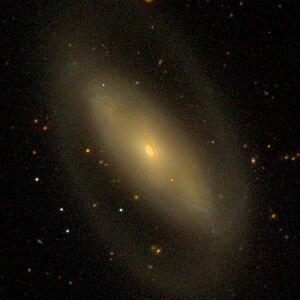NGC 5377
| Galaxy NGC 5377 |
|
|---|---|

|
|
| SDSS recording | |
| AladinLite | |
| Constellation | Hunting dogs |
|
Position equinox : J2000.0 , epoch : J2000.0 |
|
| Right ascension | 13 h 56 m 16.7 s |
| declination | + 47 ° 14 ′ 09 ″ |
| Appearance | |
| Morphological type | (R) SB (s) a / AGN |
| Brightness (visual) | 11.3 mag |
| Brightness (B-band) | 12.2 mag |
| Angular expansion | 4.7 ′ × 2.4 ′ |
| Position angle | 23 ° |
| Surface brightness | 13.4 mag / arcmin² |
| Physical data | |
| Affiliation | NGC 5448 group LGG 372 |
| Redshift | 0.005981 ± 0.000020 |
| Radial velocity | 1793 ± 6 km / s |
|
Stroke distance v rad / H 0 |
(84 ± 6) · 10 6 ly (25.9 ± 1.8) Mpc |
| history | |
| discovery | Wilhelm Herschel |
| Discovery date | May 12, 1787 |
| Catalog names | |
| NGC 5377 • UGC 8863 • PGC 49563 • CGCG 246-027 • MCG + 08-25-052 • IRAS 13542 + 4729 • 2MASX J13561666 + 4714080 • GC 3716 • H I 187 • h 1712 • NVSS J135616 + 471412 • LDCE 1043 NED002 | |
NGC 5377 is a 11.3 likes bright barred spiral galaxy with an active galactic nucleus from Hubble type SBa in the constellation Canes Venatici on the northern sky . It is estimated to be 84 million light years from the Milky Way and about 115,000 light years in diameter.
The type II supernova SN 1992H was observed here.
The object was discovered on May 12, 1787 by Wilhelm Herschel with an 18.7-inch reflector telescope, who described it as "cB, extended 30 degrees sp-nf, BN, vg faint branch".
